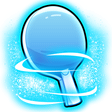Playing against dead rubbers
Strategy
Rohan Keogh Asked 7 years ago
Hi guys. Are the tactics for playing against dead rubbers the same as for anti-spin, or is it more a matter of much less spin rather than 'reversed' spin?
It can be difficult to tell how much or little spin these rubbers are generating and the opponent's stroke really doesn't help - they can look like they put a little spin on it or a lot but the ball spins the same amount either way.
What's the best way to spot the spin and avoid costly errors?
Cheers
Rohan
 Alois Rosario Answered 7 years ago
Alois Rosario Answered 7 years ago
Hi Rohan,
It depends on how 'Dead' the rubber is. If it has no friction at all then it is an anti spin rubber. Some rubbers will have lost most of their grip but will still have some grip. If it has some grip then they will be able to generate some spin of their own depending on the action of their stroke and the contact on the ball.
Seeing the spin is a tricky business. You can tell by things such as the sounds of the contact, the flight of the ball and the bounce on your side of the table. They are all things that you learn from experience and in particular experience during the time playing with that particular player.
Recommended Video
When to Use Your Best Serve in Table Tennis (Most Players Get This Wrong!)
A lot of players don’t use their best serve enough — or worse, they use it at the wrong time. In this video, Jeff and Alois break down how to make smarter decisions about when to use your strongest serve and how to adjust based on your opponent, the score, and the pressure.
✅ What you’ll learn:
- Why holding back your best serve can hurt your game
- How to recognise the right moment to use it
- What mistakes players make with serve selection
- A 3-step routine to improve your serve strategy
Your best serve should win you more than just a few points — it should help you win matches.
Watch NowNo comments yet!
Become a free member to post a comment about this question.
